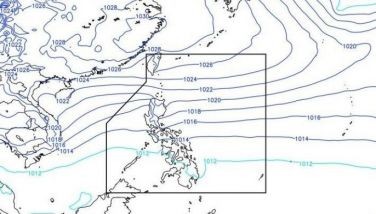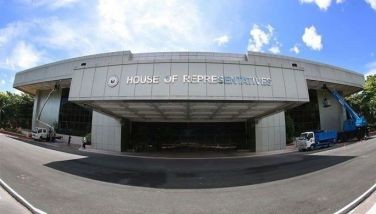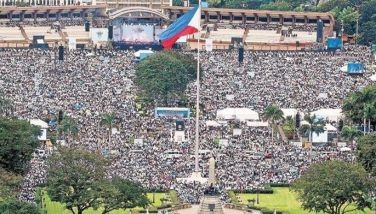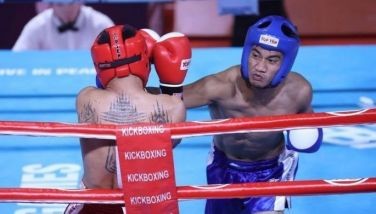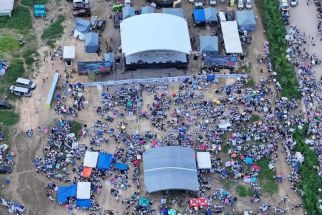Carabaos take center stage in Ilocos festivals
May 24, 2006 | 12:00am
Sto. Domingo, Ilocos Sur — Before the start of the planting season in the country’s rice granaries, the carabao (water buffalo) or the so-called "beasts of burdens" take the center stage in many Ilokano festivals in the north.
Important feasts for the carabao include Sto. Domingo’s "Arangkada Sto Domingo" and Vigan City’s "Viva Vigan," both in Ilocos Sur. The festivals draw Ilokanos closer to farmers’ best friend while luring thousands of tourists.
Coinciding with the Viva Vigan festival on the first week of May is the Karbo Festival, where carabaos are artistically painted and paraded. Days later, Sto Domingo’s one-of-a-kind carabao racing contest is held.
Sto. Domingo Mayor Floro "Butch" Tadena said the holding of the carabao race is meant to revive Ilokano villagers’ traditions and old practices, a heritage which they hope to preserve.
On May 11, amid the scorching heat of the afternoon sun in a four-hectare yet unplanted farmland here, villagers and tourists numbering close to 10,000 gather to watch locally-bred carabaos race.
This year, Iluko farmer Eddie Toledo bagged the first prize with a P5,000 cash reward. Mario Montanez took home the second prize and the P3,000 prize money while Romel Taberna went home with P2,000 for third prize.
The race, a much-awaited event during the town fiesta, is now on its sixth year.
"Since my childhood days, carabao racing has already been with us, so when I sat as mayor we revived the event not only for the purpose of preservation of our cultures but also to attract tourists," Tadena said.
Town agriculturist Mamerto Tacbas, who coordinated this year’s race, said the contest is one way of promoting the carabao, the country’s national symbol, which is now said to be dwindling in number.
Tacbas said the carabao is still the farmer’s work animal despite the proliferation of Japanese-made hand tractors.
Today, Sto. Domingo has only 603 carabaos. Although the town has the highest carabao population in the province, Tadena said they plan to breed more. And next year’s carabao race will definitely be another grand spectacle during the town fiesta.
Vigan City’s Karbo Festival, on the other hand, is an event where the carabao is exhibited as an artwork.
Vigan Mayor Ferdinand Medina said the Karbo Festival, not on its second year, "would not only promote the carabao for art but also promote its significance as a national animal.
"The carabao is already vanishing. I am confident that through our Karbo Festival, we could help in the preservation of more carabaos in the countryside," Medina said.
Campaign for the carabao preservation
The Philippine Carabao Act or Republic Act 7307, authored by then Sen. Joseph Estrada, was signed into law on March 27, 1992 by former President Corazon Aquino, speaker Ramon Mitra and senate president Neptali Gonzalez.
Estrada’s RA 7307 created the Philippine Carabao Center (PCC) and became an attached agency of the Department of Agriculture tasked to improve farmers’ income, nutrition, and general well-being through the enhancement of carabao’s potentials as a source of draft power, meat, milk and hide.
At least 13 carabao centers nationwide were created in 1993 and 1994 to implement carabao upgrading through artificial insemination and natural breeding programs.
These are the PCCs at Central Luzon State University, University of the Philippines (Los Baños), Cagayan State University, Central Mindanao University, Ubay Stock Farm, La Carlota Stock Farm, Mariano Marcos State University, Don Mariano Marcos Memorial State University, West Visayas State University, Visayas State College of Agriculture (now Leyte state University), Mindanao Livestock Production Center and University of Southern Mindanao.
The national government had also imported hundreds of Murrah and Bulgarian Buffalo breeds.
On May 14, 1993, former President Fidel Ramos also launched the National Carabao Development Program to upgrade the local carabao breed for milk and meat production.
With the advancement of science and technology, junior scientists and researchers of the centers have been conducting a series of researches to hasten the reproduction of high-breed carabaos.
The world’s first test tube "caracalf" was produced on April 5, 2002, coinciding with the 55th birthday of President Arroyo. The female calf was named "Glory."
Important feasts for the carabao include Sto. Domingo’s "Arangkada Sto Domingo" and Vigan City’s "Viva Vigan," both in Ilocos Sur. The festivals draw Ilokanos closer to farmers’ best friend while luring thousands of tourists.
Coinciding with the Viva Vigan festival on the first week of May is the Karbo Festival, where carabaos are artistically painted and paraded. Days later, Sto Domingo’s one-of-a-kind carabao racing contest is held.
Sto. Domingo Mayor Floro "Butch" Tadena said the holding of the carabao race is meant to revive Ilokano villagers’ traditions and old practices, a heritage which they hope to preserve.
On May 11, amid the scorching heat of the afternoon sun in a four-hectare yet unplanted farmland here, villagers and tourists numbering close to 10,000 gather to watch locally-bred carabaos race.
This year, Iluko farmer Eddie Toledo bagged the first prize with a P5,000 cash reward. Mario Montanez took home the second prize and the P3,000 prize money while Romel Taberna went home with P2,000 for third prize.
The race, a much-awaited event during the town fiesta, is now on its sixth year.
"Since my childhood days, carabao racing has already been with us, so when I sat as mayor we revived the event not only for the purpose of preservation of our cultures but also to attract tourists," Tadena said.
Town agriculturist Mamerto Tacbas, who coordinated this year’s race, said the contest is one way of promoting the carabao, the country’s national symbol, which is now said to be dwindling in number.
Tacbas said the carabao is still the farmer’s work animal despite the proliferation of Japanese-made hand tractors.
Today, Sto. Domingo has only 603 carabaos. Although the town has the highest carabao population in the province, Tadena said they plan to breed more. And next year’s carabao race will definitely be another grand spectacle during the town fiesta.
Vigan City’s Karbo Festival, on the other hand, is an event where the carabao is exhibited as an artwork.
Vigan Mayor Ferdinand Medina said the Karbo Festival, not on its second year, "would not only promote the carabao for art but also promote its significance as a national animal.
"The carabao is already vanishing. I am confident that through our Karbo Festival, we could help in the preservation of more carabaos in the countryside," Medina said.
Campaign for the carabao preservation
The Philippine Carabao Act or Republic Act 7307, authored by then Sen. Joseph Estrada, was signed into law on March 27, 1992 by former President Corazon Aquino, speaker Ramon Mitra and senate president Neptali Gonzalez.
Estrada’s RA 7307 created the Philippine Carabao Center (PCC) and became an attached agency of the Department of Agriculture tasked to improve farmers’ income, nutrition, and general well-being through the enhancement of carabao’s potentials as a source of draft power, meat, milk and hide.
At least 13 carabao centers nationwide were created in 1993 and 1994 to implement carabao upgrading through artificial insemination and natural breeding programs.
These are the PCCs at Central Luzon State University, University of the Philippines (Los Baños), Cagayan State University, Central Mindanao University, Ubay Stock Farm, La Carlota Stock Farm, Mariano Marcos State University, Don Mariano Marcos Memorial State University, West Visayas State University, Visayas State College of Agriculture (now Leyte state University), Mindanao Livestock Production Center and University of Southern Mindanao.
The national government had also imported hundreds of Murrah and Bulgarian Buffalo breeds.
On May 14, 1993, former President Fidel Ramos also launched the National Carabao Development Program to upgrade the local carabao breed for milk and meat production.
With the advancement of science and technology, junior scientists and researchers of the centers have been conducting a series of researches to hasten the reproduction of high-breed carabaos.
The world’s first test tube "caracalf" was produced on April 5, 2002, coinciding with the 55th birthday of President Arroyo. The female calf was named "Glory."
BrandSpace Articles
<
>
- Latest
- Trending
Trending
Latest
Trending
Latest
Recommended


























